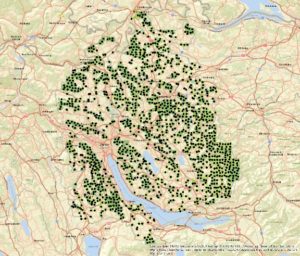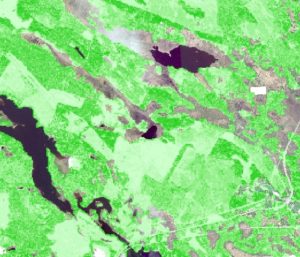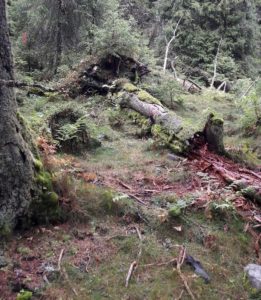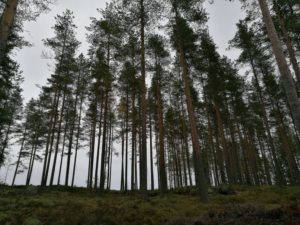This content has been archived. It may no longer be relevant
Wood production is a pivotal provisioning ecosystem service of major economic importance, yet its intensive utilisation is a key reason for species declines in the EU and globally. Thus, it is essential to modify current forestry to secure both high future timber yield and viable (meta)populations of forest species.
Our collaborative project (GreenFutureForest) uses an integrated modelling approach based on field data to answer the following four questions:
1) What are the effects of future global demands for wood products on future forestry profits and long-term viability of species in boreal and central European forests?
2) What are the opportunities for adapting forest management and conservation to limit the negative effects on (meta)populations while retaining sustainable and profitable forestry?
3) Do forest and climate variables, and landscape connectivity explain colonisation and extinction dynamics or occurrence of (meta)populations? We study both sessile and mobile species. The resulting models form the basis for our simulations.
4) Can citizen science data improve models for colonisation and extinction rates or occurrence? These data are voluntarily collected by the public, and increase exponentially.
1) Effects of future global demands for wood products on future forestry profits and long-term viability of species in boreal and central European forests?
Future global demand and regional supply of wood products
We use the Global Biosphere Management Model (GLOBIOM) model to estimate future global and regional demand of wood products. GLOBIOM is a global model of the forest and agricultural sectors, where economic optimisation is based on the spatial equilibrium modelling approach. It allows scientists and policymakers to assess the rational production forest fibre, bioenergy and food, all of which contribute to human welfare on a global and regional basis. We analyse the demand of woody products for the new IPCC scenario framework and assess the impact across the 5 different development scenarios and 5 different climate change mitigation scenarios.
The value of ecosystem resilience buffering against unexpected future risks
We are assessing how the value of forest ecosystem services such as wood may be affected by large-scale disturbances, particularly storms. Climate scenarios show that storm intensity and frequency may increase in Northern Europe. Thus, we analyse how storm damage can be “mainstreamed” or integrated into economic optimisation. According to the insurance hypothesis of biodiversity, resilient ecosystems reduce the cost of both periodic stresses like drought and disturbances like storms, hence serving as a natural insurance to the forest owner. We use an economic optimization model in Heureka to analyse the effects of storms on net present value (NPV), depending on different management scenarios.
2) Opportunities for adapting forest management and conservation to limit the negative effects on (meta)populations while retaining sustainable and profitable forestry
We are using inventory data for the test site of Augsburg Western Forests to simulate how point inventory data can be scaled to landscape-wide data. This work is critical given that detailed landscape-wide forestry data are still scarce. We then used these data to develop alternative future forest management scenarios (e.g. business as usual, bio-energy, multifunctional). This work showed that several forest structure parameters are critical for biodiversity (tree species profile index and tree species intermingling). We are currently developing two new scenarios that account at the same time for high multi-functionality of ecosystem services and very production-oriented management.
The previous simulations at the landscape scale have been extended for the Canton of Zurich (Switzerland), and for the entire state of Bavaria (Germany). We are currently developing algorithms that include different management scenarios at the large scale in order to optimise management to maximise both harvest and biodiversity, based on optimisation techniques. This set of objectives will be progressively extended to include the specific structure variables used in the biodiversity/population models (presence/absence of birds, species richness of fungi, etc.).
Apart from that, we are currently conducting a study on the biodiversity-structure-productivity relationship including also the development status of forest stands. Like that, the interdependencies between different variables, which are being optimized depending on different objectives, shall be further analysed.
3) Effect of forest variables, climate and landscape connectivity on colonisation and extinction dynamics or occurrence of (meta)populations of sessile and mobile species.

We study both mobile (birds) and sessile (wood-decaying fungi) organisms, to forecast the forest biodiversity response to changes in forest management.
3.1) Modelling distributions of forest bird
We are using an integrated modelling approach based on field data to examine how forest structure in boreal and central European forests affects bird diversity and indicator bird species in the Kanton of Zurich (Switzerland), Bavaria (Germany), and Sweden (both at local and national scale, see below). We will ultimately use these models to predict how future changes in forest management will affect biodiversity and population structure of these indicator species.
Our current research has been focused on examining what types of forest structures and properties are important for birds. Using a mix of forest inventory and aerial imagery data, along with high quality bird transect survey data, we are determining what specific forest conditions are important for different bird species and which different management schemes influence the greatest diversity.

Based on the bird data from Kanton Zurich, we use single-species empirical models for 31 forest bird species. These models will be the base of predicting how different forest structure variables will affect these species depending on different forest management scenarios. The models for the census data from Sweden are currently being developed. We are investigating forest bird richness using the same datasets to assess the effects of forest management on forest bird biodiversity. Additionally, we are assessing the influence of ecological traits of birds on their responses to forest structure.
Ongoing work uses forest variables based on remote sensing data to refine bird models, forming the base for scenario simulations over the next 100 years. The results of these models will be used to compare future forest management options. Moreover, they will allow us to compare whether Central European and boreal forest birds will differ in their response to habitat changes.
A second focus of our bird work is to examine how forest structure impacts the spatial population dynamics (e.g. survival, reproductive success, dispersal) of a group-living bird in northern Sweden, the Siberian jay (Perisoreus infaustus). This study site consists of two parts, one with pristine forests, and one where forests are intensely affected by management, including clear cutting and thinning. This species is also used below to assess the value of citizen science data.
3.2) Modelling colonisation- and extinction dynamics for wood-decaying fungi

Dynamic colonisation-extinction models are developed for several wood-decaying fungal species of conservation interest. We use these models to answer the following two questions: 1) Do dead wood and stand characteristics (i.e., the local environment) and spatial connectivity to dispersal sources, green infrastructure (i.e., the regional environment) explain occurrence and colonisation-extinction dynamics of wood-decaying fungi? 2) How do different forest management scenarios affect future metapopulation dynamics of wood-decaying fungi?
Our work is based on survey data collected primarily in Finland (see below). Colonisation-extinction models have been developed, and model selection have yielded preliminary results for the 5-10 wood-decaying fungi with different rarity The models that were developed based on Finnish data will be evaluated for application at EU scale against independent datasets collected in Norway and Germany. The work has included developing protocols for dead wood quality classification and dead wood volume calculations.
Ongoing work focuses on further refinement of the preliminary model selection results as well as on the implementation of a decomposition model to project changes in dead wood amount and quality under the different forest management scenarios using software for simulating forest dynamics and management, such as Heureka and SILVA. Once these tasks are completed, the colonisation-extinction models will be run on top of forest scenarios for study landscapes to simulate and compare future metapopulation dynamics under different forest management regimes.

We will further evaluate the ability of the models based on Finnish data for application in Norway and Bavaria, Germany. More specifically, we will investigate whether the Finnish models for colonisation and extinction can predict the colonisation and extinction events observed in Norwegian and Bavarian forests. If this is the case, our Finnish colonisation-extinction models can be applied in forestry scenario work also in these other areas. Alternatively, new colonisation extinction models will be fit to the Bavarian data, and these models will be used compared to the previous. These will next form the basis for inferring biogeographical differences in fungi species responses to forest structure, and its implications for forest management.
4) Applicability of citizen science data for population modelling
We use a range of data sets and modelling methods to test the response of a forest bird (Siberian jay) to alternative forest management. The aim of this study is to evaluate the pro and cons of different data sources and modelling methods for predictions about the future. The data consist of Sweden-wide opportunistically collected citizen science data, Sweden-wide systematically collected monitoring data and long-term demographic data from an intensively studied area in the north of Sweden (Siberian jay project).
A range of models for opportunistically collected data and one for the systematically collected data have been developed. An individual-based model is developed based on the long-term demographic data, which includes fitting sub-models for reproduction, base-line population data and dispersal. Once we have developed this model, we will apply them all to a landscape in Northern Sweden (Vilhelemina region) for which the forest development over a period of 100 years has been simulated assuming different management scenarios.
Work package leaders/PIs
Nicklas Forsell, IIASA Austria
Michael Griesser, University of Zurich
Thomas Hahn, Stockholm Resilience Centre
Jenni Nordén, Norwegian Institute for Nature Research
Arpat Ozgul, University of Zurich
Hans Pretzsch, Technische Universität München
Boris Schröder-Esselbach, Technische Universität Braunschweig
Tord Snäll (Project Coordinator), SLU Uppsala
Project participants
Ute Bradter, SLU Uppsala
Andreas Dahlkamp, Technische Universität Braunschweig
Jeanette Eggers, SLU Uppsala
Paul Haverkamp, University of Zurich
Pedro J. Leitão, Technische Universität Braunschweig
Helen Moor, SLU Uppsala
Alex Singer, SLU Uppsala
Astor Toraño Caicoya, Technische Universität München
Enno Uhl, Technische Universität München
Laura Zeller, Technische Universität München
Project publications:
Bradter U, Mair L, Jönsson M, Knape J, Singer A, & Snäll T. 2018. Can opportunistically collected Citizen Science data fill a data gap for habitat suitability models of less common species? Methods in Ecology and Evolution 9: 1667-1678.
Layton-Matthews K, Ozgul A, Griesser M. 2018. The interacting effects of forestry and climate change on the demography of a group-living bird population. Oecologia 186: 907-918.
Löbel S, Mair L, Lönnell N, Schröder B, Snäll T. 2018: Biological traits explain bryophyte species distributions and responses to forest fragmentation and climatic variation. Journal of Ecology 106: 1700-1713.
Toraño AC, Biber P, Poschenrieder W, Schwaiger F, Pretzsch H. 2018. Forestry projections for species diversity-oriented management: an example from Central Europe. Ecological Processes 7: 23.
Zeller L, Liang J, Pretzsch H. 2018. Tree species richness enhances stand productivity while stand structure can have opposite effects, based on forest inventory data from Germany and the United States of America. Forest Ecosystems 5: 4.

